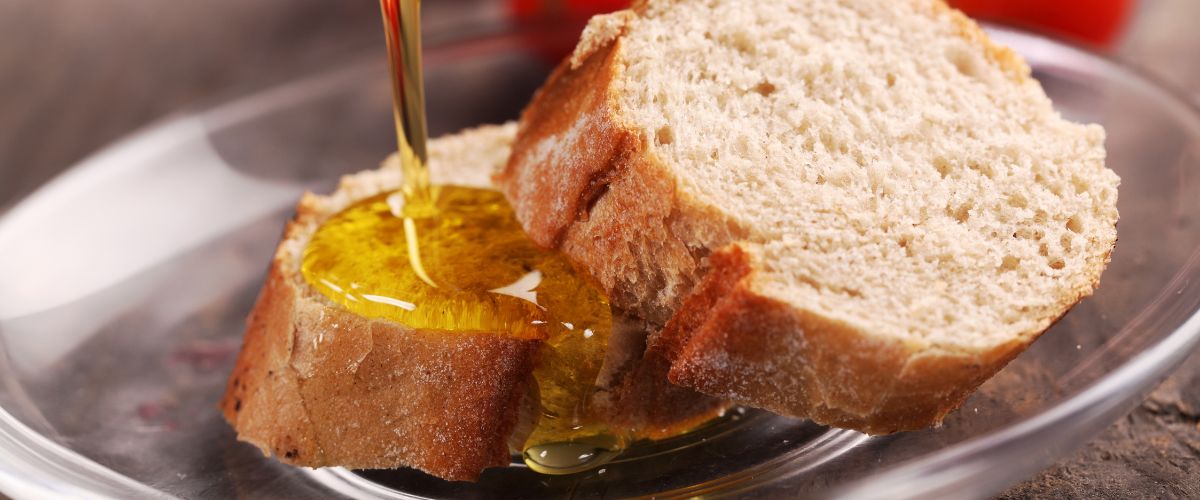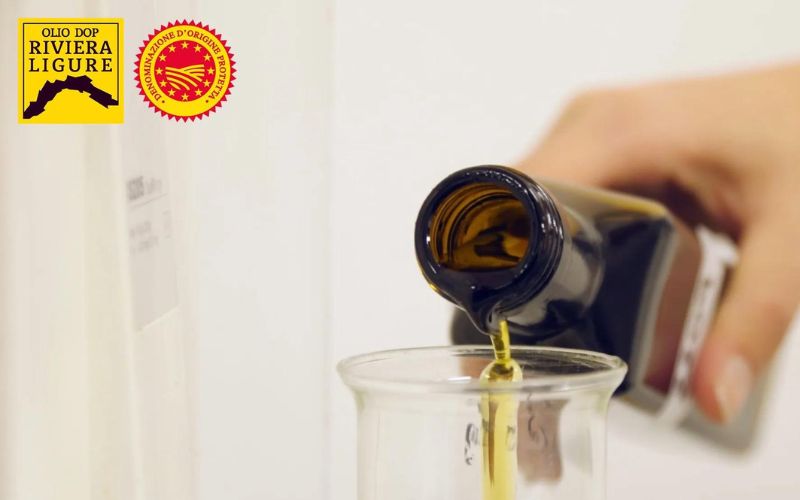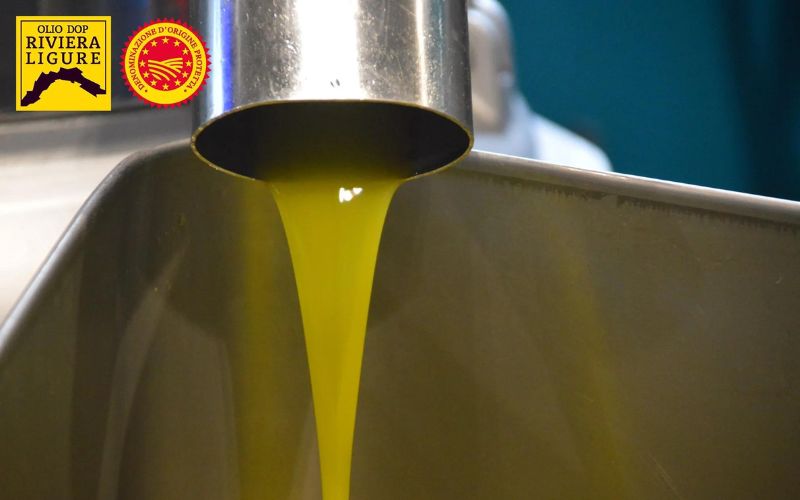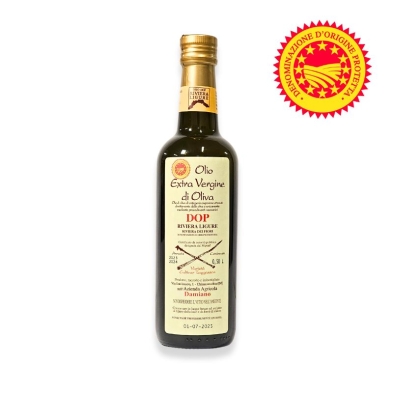Riviera Ligure PDO Extra Virgin Olive Oil
Ligurian olive oil is not just a simple condiment. It is the symbol of a territory, the pride of its people, an indispensable protagonist of the local cuisine. The link and importance of this ingredient with its environment and with Liguria is recognized by the DOP mark, which protects and guarantees the quality of this product. Only oil that has the yellow symbol of the Consortium and the PDO can be called Ligurian oil.

The characteristics of Ligurian olive oil
A sweet and smooth extra virgin oil, characterized by a balance of fruity, bitter and spicy notes. Its low acidity enriches the flavor of without changing the taste or covering the aromas of the dish. Harmonious and harmonious, hints of olive, artichoke, almond, pine nut, and herbs can be perceived on tasting.
It is used in the preparation of Ligurian and Mediterranean dishes, especially those with vegetables and fish. A very versatile oil, given its qualities it is even used in pastries.
The taggiasca cultivar
Ligurian Riviera dei Fiori PDO olive oil is obtained almost exclusively from the processing of taggiasca olives. These olives represent a selected variety of olive widespread in western Liguria, extending through the entire Province of Imperia and part of the Province of Savona. Their name suggests their origin, being closely associated with the town of Taggia, located in the Argentina Valley, now part of the Province of Imperia.
.jpg)
Given their unique qualities, Taggiasche olives are used both for oil production and as table olives (those that can be eaten, simply put). The oil obtained from these olives has distinctive characteristics, most notable among which is its sweet aroma-a light to medium fruitiness with great versatility in cooking.
As table olives, Ligurian Taggiasche are world renowned. They undergo a brine preservation process, which gives them a natural flavor, characterized by the ease with which the pulp separates from the stone. This ease of consumption makes them consistently palatable and tasty. This is also the origin of pitted olives preserved in olive oil and the renowned pate, along with other typical Mediterranean sauces such as tapenade.
The connection with Liguria
The exceptional nature of Ligurian olive oil stems from the happy meeting of a special microclimate, local olive varieties with unique characteristics, and traditional practices that are still kept alive after centuries. The steep terrain overlooking the sea has created a perfect environment for the growth of olive trees. The cultivation of the olives and the production of the oil is still done in most of their stages by hand and in a traditional way thus maintaining the final quality of the oil high.

The charm of the Ligurian territory also owes much to the local crops, with those terraces and dry stone walls (a UNESCO heritage site) that draw ancestral lines on the slopes rising from the sea. The natural beauty in the way these crops blend together with the wild elements has few comparisons in the world.
Agricultural space for olive cultivation in the western Ligurian Riviera was created from nothing by local farmers in centuries past, carving out terraces from the slopes, that is, cultivable space where none existed before. Ligurian olive oil was awarded the PDO precisely in recognition of this territorial spirit, of the importance of origin, which gives this product its unique character. This oil could only be born here.
THE QUALITY ASSURANCE OF PDO
Verified, tasted, authorized, guaranteed.
Verified for its traceability, from tree to table, to protect the consumer. An independent certification body, external to the Consortium, is in charge of inspecting olive groves, assessing their management and monitoring the entire production chain, in accordance with strict standards. This guarantees the protection of the product.
Tasted and authorized through sensory and chemical analysis conducted on each batch of oil. Only if the results meet the parameters set by the specification can the oil obtain the prestigious PDO designation. This ensures the quality and safety of the product.
Guaranteed through the issuance of a distinctive collar by the Consorzio di Tutela on each bottle of PDO oil, containing a code that leads back to the certified batch. In addition, the Consortium carries out spot checks on the market, verifying that Riviera Ligure PDO oil always conforms to established standards, repeating chemical-physical and sensory analyses. This assures consumers that they are buying a quality product.

The Consorzio per la tutela dell'olio extravergine di oliva DOP Riviera Ligure is committed to protecting and promoting an oil that is fully certified for origin and quality, involving the people, who are the true custodians of this tradition. These people, proud of their work, carefully cultivate olive groves in the hills and rural landscapes of Liguria, thus helping to preserve a precious heritage. DOP Riviera Ligure oil is an authentic extra virgin, a symbol of taste and nourishment, embodying the peculiarities of the Ligurian territory.
Each bottle of DOP Riviera Ligure, recognizable by the numbered yellow collar of the Protection Consortium, encapsulates a piece of local history and culture, conveying to the consumer the values and traditions linked to the territory. Strict adherence to the production specifications and the system of controls guarantee the quality of the product, from the beginning to the end of its production. This is the promise of quality that we want to offer consumers and restaurateurs, because good food starts with authentic, high-quality ingredients that respect the land and its traditions.
How to recognize the best extra virgin olive oil - Tasting guide
Anyone wishing to venture into tasting an extra virgin olive oil can do so by following a few basic procedures. First, one pours the oil into the glass, an amount of about a tablespoon and no more. Second, one brings the glass close to the nose, trying to perceive all the sensations, both positive and negative. Next, you gently warm the oil in the glass, swirling it with the palm of your hand to release and intensify its volatile aromatic components.
Once prepared, one tastes a sip of the oil in the mouth, sucking slowly and gently, then increasing the intensity of the suction, allowing the oil to diffuse into the oral cavity and reach the taste buds. Next, you allow the oil to reach the olfactory bulb through the retronasal route. After holding the oil in the mouth for a few seconds, moving the tongue against the palate, the suction of the oil is repeated with the lips half-open and moving the tongue again.

This process is repeated several times, keeping the oil in the mouth for at least twenty seconds before expelling it. During this stage, it is important to carefully evaluate the retro-olfactory sensations that are perceived. At the end of the tasting, the oil should be fresh and clean in its main aromas, balanced and harmonious in taste, and pleasantly savory, with good condensing power.
In evaluating oil, it is useful to become familiar with specific vocabulary describing olfactory, taste and tactile sensations. Some key terms include:
Expresses the degree to which the oil is acceptable from an organoleptic point of view.
The balanced overall feel that a good oil should offer.
The texture and density of the oil perceived in the mouth.
The complex of olfactory, gustatory and tactile perceptions of the oil.
The fresh and pleasant smell of the oil.
The characteristic olfactory sensations of oil obtained from fresh, healthy olives.
The duration of residual olfactory sensations after tasting.
The sensations perceived by the pressure of the oil on the tongue and the movement of the tongue.
Here is a guide to understanding the different olfactory, taste and tactile sensations that can emerge when tasting extra virgin olive oil:
Olfactory Sensations:
Sour, Artichoke, Grass, Aromatic herbs, Flowers, Olive leaf, Exotic fruit, Almond, Apple, Walnut, Pine nut, Tomato.
Taste Sensations:
Bitter (a flavor characteristic of oil obtained from green or veraisonous olives) and Sweet (a complex taste-kinesthetic sensation, typical of oil obtained from ripe olives).
Tactile or Kinesthetic Sensations:
Spicy (a pungent tactile sensation characteristic of oils produced early in the season, mainly from olives that are still green).
These sensations provide a comprehensive overview of the various sensory facets that can be experienced when tasting extra virgin olive oil.

